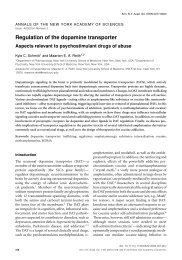The Role of Male Sexual Arousal in Rape: Six Models
The Role of Male Sexual Arousal in Rape: Six Models
The Role of Male Sexual Arousal in Rape: Six Models
Create successful ePaper yourself
Turn your PDF publications into a flip-book with our unique Google optimized e-Paper software.
624 HOWARD E. BARBAREE AND WILLIAM L. MARSHALL<br />
<strong>The</strong> concept <strong>of</strong> stimulus control has been applied to re-<br />
sponses that are acquired through a process <strong>of</strong> classical condi-<br />
tion<strong>in</strong>g and to responses that have been learned through <strong>in</strong>stru-<br />
mental learn<strong>in</strong>g. <strong>Sexual</strong> arousal responses may be learned<br />
through either process (Laws & Marshall, 1990). <strong>The</strong> follow<strong>in</strong>g<br />
discussion is not specific as to the condition<strong>in</strong>g or learn<strong>in</strong>g<br />
orig<strong>in</strong>s <strong>of</strong> the responses. <strong>The</strong>refore, our description <strong>of</strong> the pro-<br />
cess <strong>of</strong> stimulus control will use terms applicable to classical<br />
condition<strong>in</strong>g, which characterize the response as be<strong>in</strong>g elicited,<br />
whereas some authors may <strong>in</strong>terpret the response as be<strong>in</strong>g an<br />
<strong>in</strong>strumental response. A complete discussion <strong>of</strong> this issue is<br />
beyond the scope <strong>of</strong> the present paper.<br />
<strong>Sexual</strong> Preference." Cues <strong>of</strong> Force and Violence as<br />
Excitatory Cues<br />
<strong>The</strong> view <strong>of</strong> rape as a paraphiliac behavior def<strong>in</strong>es a model <strong>of</strong><br />
rape <strong>in</strong> which the subject's arousal is evoked or <strong>in</strong>creased by<br />
cues <strong>of</strong> force, nonconsent, humiliation, and so forth. Accord<strong>in</strong>g<br />
to the sexual preference hypothesis, rapist paraphiliacs engage<br />
<strong>in</strong> rape behavior because the cues associated with the act are<br />
maximally arous<strong>in</strong>g and because the act is therefore optimally<br />
reward<strong>in</strong>g or satisfy<strong>in</strong>g. This view <strong>of</strong> rape regards the behavior<br />
as analogous to other paraphilias, such as pedophilia or fe-<br />
tishism.<br />
<strong>The</strong> model <strong>of</strong> rape arousal as a paraphiliac behavior is pre-<br />
sented <strong>in</strong> Figure 2.<br />
Abel et al. (1977) recorded the sexual arousal <strong>of</strong> rapists and a<br />
group <strong>of</strong>nonrapist sexual deviates dur<strong>in</strong>g 2-m<strong>in</strong> verbal descrip-<br />
tions <strong>of</strong> mutually consent<strong>in</strong>g sex and rape. <strong>The</strong> rapists were<br />
more aroused by descriptions <strong>of</strong> forced sex than were the<br />
nonrapists. However, the rapists did not show a sexual prefer-<br />
ence for rape. As a group, the rapists were equally aroused by<br />
rape and consent<strong>in</strong>g cues, whereas nonrapists were consider-<br />
ably less aroused by rape than they were by the consent<strong>in</strong>g<br />
sexual descriptions. Soon after, these f<strong>in</strong>d<strong>in</strong>gs were supported<br />
by reports by Barbaree, Marshall, and Lanthier (1979) and<br />
Qu<strong>in</strong>sey and Chapl<strong>in</strong> (1982, 1984).<br />
However, later, <strong>in</strong> strong support <strong>of</strong> the sexual preference<br />
hypothesis, Qu<strong>in</strong>sey, Chapl<strong>in</strong>, and Upfold (1984) reported that<br />
rapists showed stronger arousal to rape cues than did non<strong>of</strong>-<br />
fenders and stronger arousal to rape cues than to consent<strong>in</strong>g<br />
cues (Qu<strong>in</strong>sey, personal communication, January, 1988). Simi-<br />
larly, Earls and Proulx (1986) reported f<strong>in</strong>d<strong>in</strong>gs from a study <strong>of</strong><br />
francophone rapists, us<strong>in</strong>g translations <strong>of</strong> the Abel, Blanchard,<br />
Becker, and Djenderedjian (1978b) verbal descriptions <strong>of</strong> rape,<br />
consent<strong>in</strong>g sex, and assault.<br />
However, Baxter, Barbaree, and Marshall (1986) reported re-<br />
sults from 60 rapists and 41 nonrapists <strong>in</strong>dicat<strong>in</strong>g that both<br />
groups showed significantly less arousal to rape than to mutu-<br />
ally consent<strong>in</strong>g cues. Similarly, Murphy, Krisak, Stalgaitis, and<br />
Anderson (1984) and Langev<strong>in</strong> et al. (1985) failed to f<strong>in</strong>d signifi-<br />
cant differences between rapists and nonrapists <strong>in</strong> their re-<br />
sponses to sexual violence.<br />
<strong>The</strong> discrepant f<strong>in</strong>d<strong>in</strong>gs <strong>in</strong> this literature are confus<strong>in</strong>g, and<br />
at this time the discrepancies are unexpla<strong>in</strong>ed. Blader and Mar-<br />
shall (1989) have suggested that the discrepancies might be due<br />
to differences among studies <strong>in</strong> the demographic characteris-<br />
Stimulus<br />
<strong>Sexual</strong> Stimulus<br />
<strong>Rape</strong> Stimulus<br />
Normal<br />
<strong>Arousal</strong><br />
n0<br />
Stimulus: <strong>Arousal</strong>:<br />
<strong>Sexual</strong> Stimulus<br />
<strong>Rape</strong> Stimulus<br />
+<br />
or<br />
0<br />
• ~ +<br />
Pathological<br />
As <strong>in</strong> Sadism-Paraphilia<br />
Figure 2. <strong>The</strong> sexual preference model.<br />
tics <strong>of</strong> the subject samples, with the more deviant samples hav-<br />
<strong>in</strong>g a psychiatric history lead<strong>in</strong>g to more deviant arousal on<br />
test<strong>in</strong>g. Barbaree (1990) has suggested that studies have used<br />
widely different methods for the construction <strong>of</strong> rape stimuli<br />
and that these methodological differences may have led to the<br />
discrepant f<strong>in</strong>d<strong>in</strong>gs. Further research is required to assess<br />
whether, and to what extent, rapists as a group show excitation<br />
<strong>of</strong> sexual arousal to rape cues.<br />
<strong>The</strong> use <strong>of</strong> the penile plethysmograph <strong>in</strong> forensic assessments<br />
<strong>of</strong> accused rapists follows directly from this model. In these<br />
assessments, arousal to deviant sexual cues is <strong>of</strong>ten taken to be<br />
an <strong>in</strong>dication <strong>of</strong> a sexual <strong>in</strong>terest <strong>in</strong> the deviance, or a sexual<br />
preference. It is beyond the scope <strong>of</strong> this article to discuss the<br />
uses and misuses <strong>of</strong> sexual preference data <strong>in</strong> forensic assess-<br />
ments. However, plethysmographic assessments <strong>of</strong>ten result <strong>in</strong><br />
the <strong>in</strong>ference <strong>of</strong> a sexual preference, when such an <strong>in</strong>ference is<br />
an oversimplification. Recognition <strong>of</strong> other models <strong>of</strong> rape<br />
arousal, as presented here, may discourage such oversimplifica-<br />
tion.










